-
Posts
679 -
Joined
-
Last visited
-
Days Won
2
Content Type
Profiles
Forums
Blogs
Gallery
Events
Store
Posts posted by Lukasz Gaszewski
-
-
Hello Lukasz,
Thanks for that information ! Apparently Verdun did not receive the Virtuti Militari but the War Cross (see the earlier post in this thread).
Cheers,
Hendrik
Hi Hendrik,
It was VM for sure! I've consulted sources for details. Verdun was awarded the Virtuti Militari on February 6, 1921, personally by Marshal Pilsudski during his visit to France. Most probably the name of the order was incorrectly registered as Croix de Guerre. Glad being able to correct the mistake.
Merry Christmas!
Lukasz
0 -
-
-
I do not have much hope, but perhaps someone will be able to assist. I have recently been asked to help identify these three Polish badges:
1. A pre-WWII railway badge, probably of a railway engineers' organization. The abbreviation on it reads "ZPIK".
2. A pre-WWII badge, probably related to an automobile (military?) organization. The abbreviation reads "SKIZAK".
3. A contemporary legal badge. The scroll reads "PRAWO : OJCZYZNA : HONOR" (law, country, honor).
Any help will be greatly appreciated.
Lukasz

 0
0 -
Places awarded with the Polish order Virtuti Militari:
1. Lw?w (Germ. Lemberg, Ukr. Lviv) - November 11, 1920
2. Verdun - ?
3. Warsaw - December 23, 1940
4. Polish War Cementery at Katyn - 1976 (initially the award of the Polish Gvt. in Exile went to the Katyn Monument in London, after 1991 transferred to the cementery itself).
0 -
Just to complete the excellent description by haynau: there also existed the Large Gold Milit?rverdienstmedaille, established by emperor Franz-Joseph on April 1, 1916. Unlike the silver and bronze ones, the gold medal was intended to general officers only. It was larger (38 mm) and the surmounting crown was surrounded by a laurel wreath. A laurel wreath also surrounded the obverse of the medal. It was worn on the war ribbon and could be conferred up to four times, the subsequent ones being denoted by gold bars. It was a very high decoration, ranking right under the Order of the Iron Crown 1st Class and the Commander of St. Stephen and before the Grand Cross of the Order of Franz-Joseph. In 1917 the effigy of Franz-Joseph was replaced by that of emperor Karl.
The medal was one of the rarest Austro-Hungarian awards. It was bestowed upon only 30 persons, most of which three-star generals or higher, out of which four persons received it twice. The only two known instances of the medal being awarded to a non-general were Oberstleutnant Pokorny from the Austrian General Staff Corps and linienschiffsleutnant Freiherr von Banfield (1890-1986), an eminent pilot and recipient of the Order of Maria Theresia.
Lukasz
0 -
Lt. Gen. Wladyslaw Anders, commanding general of the 2nd Polish Army Corps in the Middle East, later C-in-C of the Polish Armed Fores in the West, proudly wearing his Wound Badge with stars for eight (!) wounds he obtained.
(source: http://www.videofact.com/polska/gotowe/a/anders/anders.html)
Lukasz
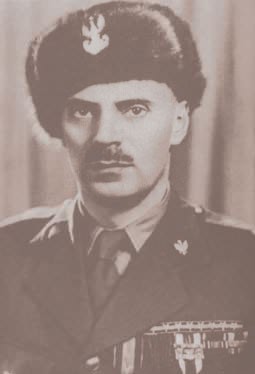
 0
0 -
I guess many Bulgarian orders were manufactured by Firma Rothe in Vienna. Some pieces were also made by Johann Schwerdtner, also in Vienna.
Lukasz
0 -
I am glad there has been so much response
 And here's some clarification regarding the order. First, it may not be clearly seen on the photos, but the enamel is actually very dark blue, not black. And although the order is indeed much inspired by the Virtuti Militari, much effort has been put to make the insignia as unique as possible, without any earlier ancestors. Also it is probably the only order in the world with the commander class in silver instead of gold.
And here's some clarification regarding the order. First, it may not be clearly seen on the photos, but the enamel is actually very dark blue, not black. And although the order is indeed much inspired by the Virtuti Militari, much effort has been put to make the insignia as unique as possible, without any earlier ancestors. Also it is probably the only order in the world with the commander class in silver instead of gold.As for the crown, it has rightly been said here, it is the symbol of sovereignity rather than royalty. The one surmounting the cross is the crown of King Boleslaus the Valiant (Chrobry), the first crowned ruler of Poland. His crowned effigy can be found on one of Polish banknotes.
Lukasz

 0
0 -
Here are the photos of the actual Order of the Military Cross. Probably the first photos of this order ever. Enjoy!

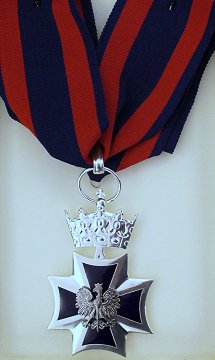
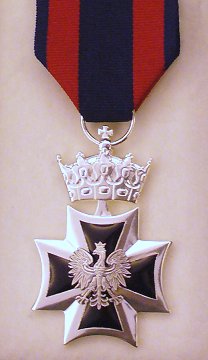


 0
0 -
Hi All,
I am sorry I could not join the discussion earlier. I am just back from London where I had a pleasure to participate in the launch of Burke's World Orders of Knighthood and Merit.
The idea of the project sounds fascinating indeed. I have been thinking of publishing a book like this myself. I will be glad to lend a hand with the project. I have been doing medal research for over twenty years now and I have collected a nice library of not only books on the subject, but of official bulletins of different countries with regulations regarding awards as well. I can read a few Eastern Bloc languages, including Bulgarian, Czech, German, Hungarian (!), Polish, Romanian, Russian and Serbo-Croat, which I think can be an asset.
The problem with me can be that I am not very much a collector (although I have a small collection of selected items), so I will not be able to provide many items for illustration.
I can write the Polish section and possibly also some other sections which will be not covered by other authors (I recently wrote articles about the medals of Bulgaria and Romania). I will also be glad to help coordinate the project, or may even consider coordinating it myself, oprovided I can share my duties with another individual. I can also try arranging publication of the book in Poland which may help reduce costs.
I agree that the most essential for the start is to select the time frames covered by the book and the countries to be included. I have made a list of the countries which at one point of their history used the "people's" or "socialist" adjective in their names (I am still not sure if I have included all):
EUROPE
Albania, Bulgaria, Czechoslovakia, East Germany, Hungary, Poland, Romania, Soviet Union, Yugoslavia.
ASIA
Afghanistan, Burma (Myanmar), Cambodia, China, Laos, Mongolia, North Korea, Vietnam, Yemen.
AFRICA
Angola, Ethiopia.
NORTH AMERICA
Cuba
The next thing will be to determine the scope of content for each contry and each entry.
Anyway I am glad Eric has put forward this excellent idea I will be more than happy to assist.
Lukasz
0 -
A closer look.
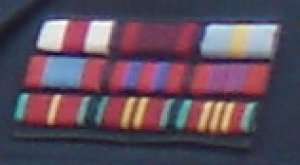
 0
0 -
On the website of the Mongolian General Staff I found this photo of a Mongolian MG with his Turkish colleague. Have a look at the last row of his ribbon bars. They are strikingly similar to those of the Soviet long service medals and may serve the same purpose. They are also similar to the colors of the badges posted by Ed.
I cannot recognize the third ribbon in the upper row, next to that of the Combat Merit Medal. If it is the Order of the Polar Star, the precedence would be incorrect.
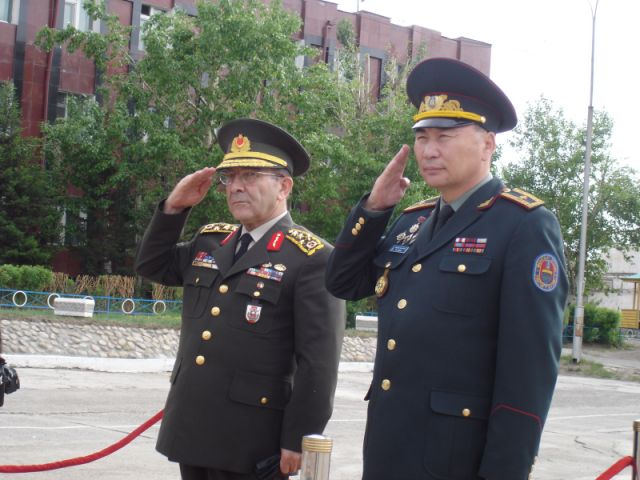
 0
0 -
Thanx Ed... Yep, very likely although there should be a dove on the ribbon. The other one is rather the Medal of 90th Birthday Anniversary of Dimitrov.
0 -
Thank you Bob and Ed, your words always help me keep my head up high
 . As of Bob's question: the photo is not very clear but it is likely to be the German Peace Prize Medal. It is easier for me to identifiy the one next to it (on the red bar) which I think to be the medal of the Dimitrov Prize.
. As of Bob's question: the photo is not very clear but it is likely to be the German Peace Prize Medal. It is easier for me to identifiy the one next to it (on the red bar) which I think to be the medal of the Dimitrov Prize.L.
0 -
And here are my findings. I am not sure of all his awards, but I think I could identify most of the ribbons.
A. Tsedenbal as a General of the Army:

1. Order of Sukhbaatar
2. Order of Sukhbaatar (x4)
3. Order of Lenin (x2), Order of the October Revolution, Order of Kutuzov - 1st Class
4. Order of the Red Banner (x2) (Mongolia), Order of the Red Banner of Labor Valor, Medal "50 Years of the Mongolian People's Revolution"
5. Order of Karl Marx (GDR), Order of Georgi Dimitrov (x2) (Bulgaria), Order of the Flag - 1st class w. Diamonds (Hungary)
6. Order of the National Flag - 1st Class (N. Korea), Order of Polonia Restituta - Grand Cross (Poland), Order of Merit - Grand Cross (Poland)
7. Order of the White Lion (Czechoslovakia - ?? wrong ribbon but corresponds with the star he is wearing), Order of Jose Marti (Cuba - the pre-1979 type), Star of Friendship of Nations (GDR)
8. Lenin Centenary Medal (USSR), Order of the Grand Star (Yugoslavia), Medal of Friendship (Mongolia), Medal of Khalkhin Gol (??)
9. Medal for the Victory over Germany, Medal of 20th Anniversary of of Great Patriotic War Victory, Medal of 30th Anniversary of of Great Patriotic War Victory, Medal for the Victory over Japan
10. Medal "30th Anniversary of the Victory at Khalkhin Gol", Medal "We Won", Medal "30th Anniversary of the Victory over the Militaristic Japan, Medal "25 Years of the MPR"
11. Medal "40 Years of the MPR", Medal "50 Years of the Mongolian People's Army", Medal "50 Years of the State Security of the MPR", Medal 50 Years of the Police of the MPR"
B. and after his promotion to Marshal of Mongolia in 1979:

1. Order of Sukhbaatar (x4)
2. Order of Sukhbaatar, Order of Lenin (x2), Order of the October Revolution
3. Order of Kutuzov - 1st Class, Order of the Red Banner (x2) (Mongolia), Order of the Red Banner of Labor Valor
4. Order of Karl Marx (GDR), Order of Georgi Dimitrov (x2) (Bulgaria), Order of the Flag - 1st class w. Diamonds (Hungary)
5. Order of the National Flag - 1st Class (N. Korea), Order of Polonia Restituta - Grand Cross (Poland), Order of Merit - Grand Cross (Poland)
6. Order of the White Lion (Czechoslovakia - ??), Order of Jose Marti (Cuba), Order of Friendship of Nations (GDR)
7. Order of the Grand Star (Yugoslavia), Medal of Friendship (Mongolia), Medal "50 Years of the Mongolian People's Revolution", Medal "50 Years of the Mongolian People's Army"
8. Lenin Centenary Medal (USSR), Medal for the Victory over Germany, Medal of 20th Anniversary of of Great Patriotic War Victory, Medal of 30th Anniversary of of Great Patriotic War Victory
9. Medal for the Victory over Japan, Medal "60th Anniversary of the Soviet Army" (??), Medal "30th Anniversary of the Victory at Khalkhin Gol", Medal "30th Anniversary of the Victory over the Militaristic Japan
10. Medal of Khalkhin Gol (??), Medal "We Won", Medal "25 Years of the MPR", Medal "40 Years of the MPR"
11. Medal "50 Years of the State Security of the MPR", Medal "40th Anniversary of the Victory at Khalkhin Gol", Medal 50 Years of the Police of the MPR", Medal "30 Years of the German Democratic Republic" (GDR ??)
The two awards above are of course the Gold Star of the Hero of MPR and the Gold Soyombo of the Hero of Labor. The cravat decoration is the star of the Marshal of Mongolia, closely modeled on the stars of Soviet Marshals.
0 -
OK, let me try. First I allowed myself to copy the photos of comrade Yumjaagiyn Tsedenbal from another thread. Particularly helpful were these two photos of his in full glory, wearing all his gongs:

 0
0 -
Dear Eric, Dear All,
I am glad to inform that the Albanian section has been added to medals.lava
 . Please have a look at http://www.medals.lava.pl/al/al2.htm. Thank you Eric once again for the assistance. The page would not be possible without your excellent work.
. Please have a look at http://www.medals.lava.pl/al/al2.htm. Thank you Eric once again for the assistance. The page would not be possible without your excellent work.Lukasz
0 -
Christophe,
I would like to know, too. I want to try to buy a copy of this issue.
 Doc
DocMe too, me too!!
0 -
Mmmm... excellent hunting!!! I wonder if it is possible to get a copy of this magazine. Does the Kazakh Mint have a website?
There are not too many good sites about contemporary awards of Kazakhstan. Here is one I found. I guess it may be known to some of you, but just in case you don't know it...
http://www.kazakhstan.orexca.com/awards_kazakhstan.shtml
Best regards,
Lukasz
PS: Do you know the width of the ribbons of Kazakh medals?
0 -
Two other pictures:

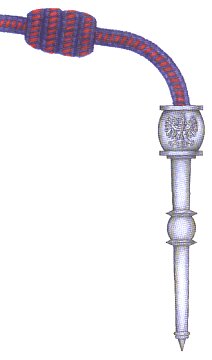

 0
0 -
I am pleased to announce that Poland has a new military order.
Yesterday, on the Independence Day of November 11, President of the Republic awarded first six individuals with the newly established Order of the Military Cross.
The order, established on October 18, is intended to recognize outstanding military leadership or acts of valor during non-wartime operations and missions of the Polish Armed Forces outside the borders of the Polish Republic or counteracting terrorist attacks. The name refers to the Order Virtuti Militari, as it was called in the era of the Duchy of Warsaw (1807-15). The order is conferred in three classes: GC (neck decoration w. star), Commander and Knight. GC can be awarded to a unit commander for outstanding leadership or initiative combined with efficient commanding a military operation or action. Commander Cross - to a unit commander or another commissioned officer for meritorious leadership or deed, resulting in a successfully performed military operation or action, or to any officer, NCO or private who has been previously awarded the Knight Cross for an act of combat valor at a risk of life; in exceptional circumstances this class can be conferred to a staff officer for collaboration with the commander if the collaboration resulted in a success of the operation or action. Knight Cross - to any officer, NCO or private for an act of combat valor at a risk of life; this class can be conferred to a civilian or to a military unit. Soldiers of the unit awarded with the Knight Cross are authorized to wear a fourragere in the colors of the order's ribbon. Please note that it is the first fourragere in the Polish medallic history ever!
In the future the reccommendations will be approved by a chapter of six, selected from recipients of the order.
The initial idea to extend the highly respected Polish Order Virtuti Militari to be awarded for peacetime operations as well (as it is the case with the Victoria Cross and the Medal of Honor) faced strong disapproval from both WWII veterans and the order's chapter, which seemed to reflect general reluctance to Polish military presence in Afghanistan and particularly in Iraq. Hence the idea of an entirely new award.
The President awarded five soldiers on the mission in Iraq with the 3rd class of the order, including one posthumous award to a soldier who had been killed as a result of a mine blow a day earlier. The only 2nd class went to MG Bronislaw Kwiatkowski, currently commanding the Multinational Division Central-South in Iraq.
Enclosed are the drawings of the order's badges. I don't have any photo of the order at the moment. I will post it as soon as I have any availiable.
More here: http://www.medals.lava.pl/pl/pl4a.htm#omc

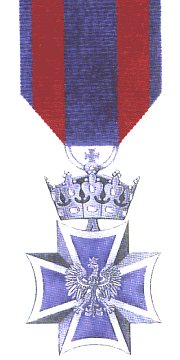
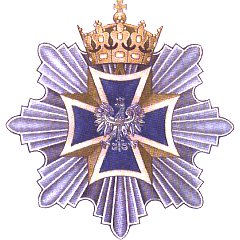


 0
0 -
Dear Eric,
I deeply bow before you. You did a great job indeed to solve the mystery of the most unknown award system in Europe. Your name will be deeply imprinted in the history of medallic science.
I would like to add Albanian ribbons to my http://www.medals.lava.pl site. I do hope you will not object if I use the information from your book, all credits to your work being given of course.
I have been desperately trying to find out any images of current Albanian awards - all in vain so far. I have contacted various Albanian institutions, but they have all a strange habit of ignoring any letters directed to them

Congratulations again on the excellent work!
Lukasz
0 -
Beautiful photos!
BTW: this is the second type of the order, issued under the Italian occupation (1940-43). While the badge remained basically the same as before the war, it has the distinctive 'love knots' (you can see them also in the Italian Orders of Annunciation and of the Crown of Italy), with letters 'FERT' and crossed fasces below. Also the Albanian crown in the medallion has been turned so that it faces East rather than West.
0



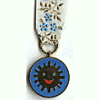
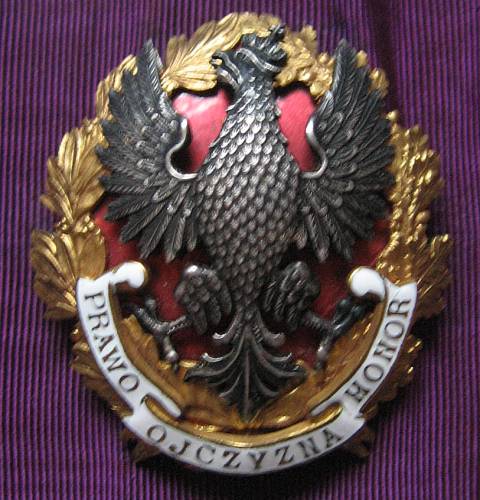

US Service Medals from Civilian and Military Goverment Agencies.
in United States of America
Posted · Edited by Lukasz Gaszewski
Darrell,
I really appreciate and admire your collection. I do not know why folks tend to focus on US military awards only and disregard civilian ones. Do post more, please! And here is a small addition from myself - the Secretary of Defense Meritorious Civilian Service Medal.
Merry Christmas,
Lukasz